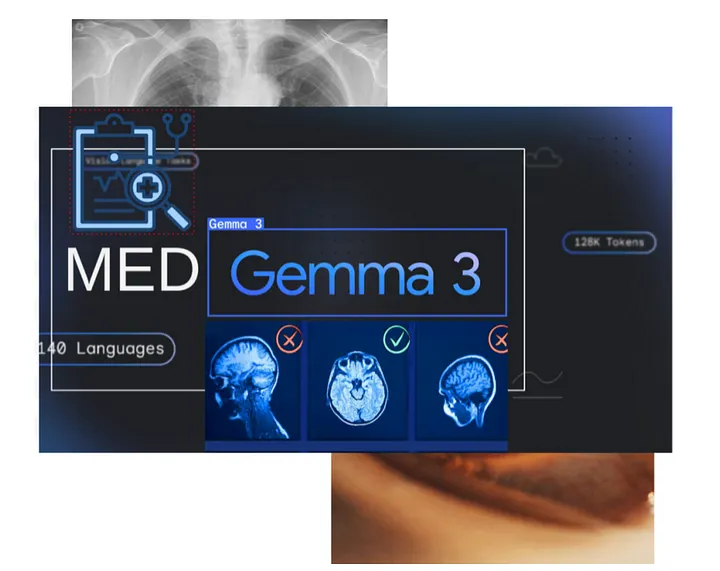MedGemma 27B, one of Google’s most capable open-source healthcare AI models, offers advanced multimodal reasoning across medical text and imaging inputs. While its potential to accelerate clinical research and support diagnostic workflows is significant, accessing and evaluating such a large model—approximately 54 GB in full precision—can be daunting. This article details the primary avenues for testing MedGemma 27B online, weighing cost, hardware requirements, ease of use, and suitability for research versus production scenarios.
1. Google Colab: A Free but Limited Launchpad
For researchers and developers seeking zero-cost experimentation, Google Colab remains the most attractive starting point. Colab offers free GPU access—often NVIDIA A100s—that can host a quantized version of MedGemma 27B.
To experiment in Colab:
- Open the official Google Health quickstart notebook:
https://colab.research.google.com/github/google-health/medgemma/blob/main/notebooks/quick_start_with_hugging_face.ipynb. - Select Runtime > Change runtime type and choose an A100 GPU.
- Execute cells sequentially to install
transformers, authenticate with Hugging Face, and download the 4-bit quantized model. - Run sample inference calls on medical text or CT/X-ray images.
Advantages:
- Zero monetary cost for limited sessions
- Preconfigured environment for rapid setup
Limitations:
- GPU availability can be inconsistent
- Session timeouts at around 12 hours
- Memory constraints requiring aggressive quantization
Colab enables proof-of-concept exploration but is unsuitable for sustained testing or production-grade workloads.
2. Hugging Face: Direct Model Hosting and API
Hugging Face hosts MedGemma 27B in text-only (google/medgemma-27b-text-it) and multimodal (google/medgemma-27b-it) flavors. Researchers granted access can leverage both the Python SDK and hosted inference APIs.
Getting started:
- Request access by agreeing to the Health AI Developer Foundation terms.
- Install dependencies:python
pip install transformers accelerate - Authenticate:python
from huggingface_hub import login login(token="YOUR_TOKEN") - Load a quantized model:python
from transformers import AutoModelForCausalLM, AutoTokenizer, BitsAndBytesConfig bnb_config = BitsAndBytesConfig(load_in_4bit=True) tokenizer = AutoTokenizer.from_pretrained("google/medgemma-27b-it") model = AutoModelForCausalLM.from_pretrained( "google/medgemma-27b-it", quantization_config=bnb_config, device_map="auto" ) - Perform generation:python
input_ids = tokenizer("Patient presents with shortness of breath.", return_tensors="pt").input_ids.to(model.device) output = model.generate(input_ids, max_new_tokens=128) print(tokenizer.decode(output[0]))
Advantages:
- Seamless integration via API
- Choice of quantized and full-precision versions
Limitations:
- Requires hardware with at least 16 GB VRAM for quantized models
- API costs accrue per token or per inference call
Hugging Face is ideal for controlled experiments and small-scale proof of concept deployments.
3. Google Cloud Vertex AI: Scalable Production Endpoint
For production-grade applications, Google Cloud’s Vertex AI is the recommended platform. Vertex AI’s Model Garden facilitates one-click deployment of MedGemma 27B as a managed endpoint.
Deployment steps:
- Enable Vertex AI in your Google Cloud project.
- Navigate to Vertex AI > Model Registry and select MedGemma 27B.
- Choose endpoint configuration: CPU, GPU (A100/H100), and autoscaling parameters.
- Deploy and obtain an HTTPS endpoint.
- Invoke via REST or Python client:python
from google.cloud import aiplatform client = aiplatform.gapic.PredictionServiceClient() endpoint = client.endpoint_path("PROJECT", "LOCATION", "ENDPOINT_ID") response = client.predict(endpoint=endpoint, instances=[{"text": "Interpret chest X-ray for nodules."}]) print(response.predictions)
Advantages:
- High availability with SLA
- Autoscaling for workload spikes
- Integrated monitoring and logging
Limitations:
- Higher cost: starts around $0.05 per 1,000 tokens
- Configuration complexity: requires Cloud IAM and networking setup
Vertex AI is best suited for teams ready to invest in a robust, secure endpoint for user-facing or clinical research tools.
4. Third-Party GPU Cloud Providers
Beyond Google’s own offerings, several niche cloud vendors facilitate rapid MedGemma 27B testing via GPU instances or managed interfaces:
- NodeShift Cloud: Offers A100/H100 VMs starting from $0.012/hour. Community tutorials illustrate Gradio integration for browser-based demos.
- Hyper.ai: Provides a one-click MedGemma 27B deployment with A6000 GPUs. The platform spins up an interface within minutes and bills by usage duration (~$0.03/minute).
- DIY on AWS/Azure: With open-source instructions, you can provision p4d or ND A100 instances, install Docker, and run MedGemma in containers. This route offers full control at the expense of manual setup effort.
5. Quantized Model Variants for Enhanced Accessibility
To lower hardware barriers, the community and Google have released quantized versions:
- 4-bit static quantization (~14 GB model size)
- 8-bit floating-point (FP8) quantization (~27 GB)
- Dynamic quantization for binary image/text workloads
These variants can often run on consumer GPUs with 16 GB VRAM, albeit with modest latency increases.
MedGemma 27B’s advanced medical reasoning capabilities can be explored through a spectrum of online methods:
- Google Colab for zero-cost, short-term experimentation
- Hugging Face for API-driven research using quantized models
- Vertex AI for scalable, production-ready deployment
- Third-party GPU clouds for rapid demos and custom environments
- Quantized variants to accommodate limited hardware resources
Early experimentation should begin on Colab to validate use cases, then graduate to Hugging Face or third-party GPUs for more intensive testing. When ready for deployment, Vertex AI provides the reliability and security required for clinical and enterprise applications. By selecting the right access path, researchers and developers can harness MedGemma 27B’s power to advance healthcare AI projects without unnecessary overhead.


